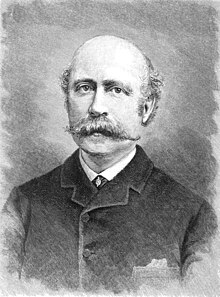Henry Bradford Nason
Henry Bradford Nason (born June 22, 1835 in Foxborough , Massachusetts , USA , † January 17, 1895 in Troy , New York , USA) was an American chemist and geologist .
Life
Henry Bradford Nason, who showed great interest in geology as a student, attended college in Amherst, Massachusetts, where he graduated in 1855. He then went to Göttingen and studied chemistry and natural sciences. He completed his studies with a Dr. phil. from. When he left Georgia Augusta , the Hannovera fraternity made him an honorary member. Nason worked for some time with the chemist Robert Bunsen in Heidelberg and with the metallurgical specialist Carl Friedrich Plattner in Freiberg (Saxony) before he returned to the USA in 1858.
First he got a job as a lecturer in natural history at the Rensselaer Polytechnic Institute in Troy (New York) . Soon after, he became a professor of chemistry and science at Beloit College in Beloit, Wisconsin . He worked for a time at both universities before teaching chemistry and mineralogy only in Troy from 1868 onwards. His university activities left him time for long study trips. He not only carried out geological studies in the southern United States and California, but also visited Europe several times. In 1861 he was first in Holland, Belgium, Ireland and Scotland, then he enrolled again in Göttingen in November to deepen his knowledge of mineralogy with the geologist Wolfgang Sartorius Freiherr von Waltershausen . He then visited glaciers in Switzerland and volcanic areas in Italy. In the summer of 1877, he was in Finland and Russia in search of rare plants for a botanical work. In 1884 he traveled to Norway to study glaciers and fjords.
In 1878 US President Rutherford B. Hayes gave him a special assignment for a trip to Europe: Nason was supposed to find out at the world exhibition in Paris whether there were chemical-technical innovations that could be of importance for the further development of the USA.
In the course of time, Nason placed the focus of his research activities more on the field of petrochemicals and published related findings. He was a consultant to the Standard Oil Company for almost 15 years . He was a member of several scientific societies and associations for the advancement of industry, so in the American Association for the Advancement of Science, in the Society of the Chemical Industry, in the American Institute of Mining Engineers, in the American Chemical Society (of which he was President 1889/90) and at the Academy of Sciences in New York. He was also one of the founders of the Geological Society of America. In addition, Nason was a member of the German Chemical Society and the Chemical Society in London.
Henry Bratford Nason wrote several textbooks and co-authored others. He translated a work by his Göttingen academic teacher Friedrich Wöhler into English.
American biographies highlight Nason's pedagogical skills, which enabled him to easily impart the necessary knowledge to his students.
Honor
The Rensselaer Polytechnic Institute in Troy gave its name to a student residence for freshmen on campus.
Works
- Table of Reactions for Qualitative Analysis, Troy 1865
- Wohler (Wöhler) / Nason, Handbook of Mineral Analysis, Philadelphia 1868 (translation)
- Table for Qualitative Analysis in Colors, Troy 1870
- Elderhorst, Manual of Blowpipe Analysis, and Determinative Mineralogy, with Charles F. Chandler, Philadelphia 1873; 1875; 1876; 1880
- Proceedings of the Semi-Centennial Celebration of the Rensselaer Polytechnic Institute, Troy 1875
- Biographical Record of Officers and Graduates of Rensselaer Polytechnic Institute, Troy 1887
literature
- The National Cyclopaedia of American Biography, Volume II, New York: James T. White & Company, 1921, p. 157
- Dumas Malone: Dictionary of American Biography, Volume XIII, London & New York: 1934, p. 390
- WHO WAS WHO IN AMERICA, Historical Volume 1607-1896, Chicago: 1967, p. 455
- Henning Tegtmeyer : Directory of members of the fraternity of Hannovera Göttingen, 1848–1998 , Düsseldorf 1998
Individual evidence
- ^ Wohler / Nason, Handbook of Mineral Analysis, Philadelphia 1868.
- ^ Rensselaer Polytechnic Institute: Nason Hall
| personal data | |
|---|---|
| SURNAME | Nason, Henry Bradford |
| BRIEF DESCRIPTION | American chemist and geologist |
| DATE OF BIRTH | June 22, 1835 |
| PLACE OF BIRTH | Foxborough , Massachusetts , USA |
| DATE OF DEATH | January 17, 1895 |
| Place of death | Troy , New York , USA |
